
President Mzee Jomo Kenyatta cuts a tape to officially open Uchumi House on Aga Khan Walk on July 27, 1973. FILE PHOTO | NMG
Summary
- A nation without a good balance of critical skills at diploma and graduate levels can neither effectively compete with the rest of the world nor meet its basic socioeconomic needs.
- Jubilee government has been rebalancing its TVET and university education, having lost capacity to create technical skills somewhere along the way.
A nation without a good balance of critical skills at diploma and graduate levels can neither effectively compete with the rest of the world nor meet its basic socioeconomic needs. Jubilee government has been rebalancing its TVET and university education, having lost capacity to create technical skills somewhere along the way.
At high public cost, the country has been producing hundreds of unemployable graduates, while struggling to meet urgent demands for diploma technical skills
The narrative below explains how at independence the founding President Jomo Kenyatta created from scratch a perfect balance of critical skills at both diploma and graduate levels.
The colonial Kenya manpower policy leveraged African manual, artisan, and clerical labour to support a white managed administration and economy. As a national priority, Jomo fast tracked creation of new skills at both diploma and graduate levels to drive agriculture, manufacturing, infrastructure, entrepreneurship, and social services, in line with his rallying call to eliminate ignorance, poverty and disease.
The starting point was creation of an adequate pool of secondary (Form Four) and higher secondary (Form Six) students to feed new diploma colleges and University of Nairobi respectively. Establishing new high schools including Harambe schools became a top priority. However, availability of high school teachers became an urgent challenge
Churches brought in expatriate missionary teachers. American Peace Corps volunteers came in large numbers to teach in new secondary schools. Form Six leavers waiting to join universities became temporary secondary schools’ teachers.
Educated refugees from Sudan and later from Uganda taught in our secondary schools. The late John Garang of South Sudan, actually taught at a new Hiriga High School near Karatina in 1964 when he was a refugee in Kenya.
Perhaps the biggest project to multiply number of high school output, was creation of Kenyatta College. The British Army had vacated their Kahawa Garrisons at Independence, and within a couple of months Kenyatta College was set up on the garrison site with two sections. One section to mass-produce high school S1 teachers, and the other to mass-supply Form Six students to join various university faculties. Prior to this, Kenya had only six high schools will A-level classes (The two Alliances, Strathmore, Maseno, Shimo La Tewa and Kangaru).
Concurrently, a new Kenya Science Teachers College (funded by Swedish government) specifically produced science teachers for high schools. Kenya Technical Teachers College was also set up to train teachers for technical colleges.
Kenya Polytechnic was the center of excellence for TVET skills development especially in areas of construction engineering. Provincial polytechnics and technical training colleges were established, to be followed in the 1970s by community funded Institutes of Advanced Technologies.
Egerton College, a European agricultural training institution, became the premier agricultural training college to create managers and agronomists for various crop sectors, research centres, while supporting regional agricultural training institutes. Within a short time, Kenya was a professionally managed agricultural economy to be envied by the rest of Africa.
Specialised infrastructure parastatals (power, railways, postal, telecoms, aviation) were concurrently running their training schools to produce critical technical skills, and these absorbed many Forms Four leavers. This is how these companies replaced expatriate technical personnel.
In respect of university skills, I believe the reforms the UoN Vice Chancellor Professor Stephen Kiama is planning will mirror the early excellence achieved by the university in the 1960/70s. That is professionally managed and sufficiently resourced faculties that produce quality graduates in various academic and professional disciplines to meet defined skills gaps in Kenya.
By early 1970s the Government had Kenyanised most of the civil service, while embarking on mandatory Kenyanisation in the private sector to absorb local skills.
The Kenyanisation Bureau was established to review expatriate work permits before processing by Immigration departments. The companies had to demonstrate firm training and succession plans to replace expats with locals. This invariably accelerated skills acquisitions at all levels of management in the private sector.
There is no reason why Kenya cannot re-examine its current skills demands and restructure its outputs from TVET colleges and universities.
The starting point is with universities reforms and sufficient funding for TVET education, which the Jubilee government has been expanding. We can borrow from the skills building process undertaken at Independence .





No comments :
Post a Comment